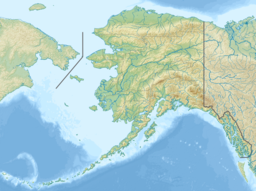
The Exxon Valdez oil spill occurred in Prince William Sound, Alaska, on March 24, 1989. Exxon Valdez, an oil supertanker owned by Exxon Shipping Company bound for Long Beach, California struck Prince William Sound's Bligh Reef, 1.5 mi (2.4 km) west of Tatitlek, Alaska at 12:04 a.m. and spilled 10.8 million US gallons (257,000 bbl) of crude oil over the next few days.

Valdez is a city in the Chugach Census Area in the U.S. state of Alaska. According to the 2020 US Census, the population of the city is 3,985, up from 3,976 in 2010. It is the third most populated city in Alaska's Unorganized Borough.

The Alyeska consortium refers to the major oil companies that own and operate the Trans-Alaska Pipeline System (TAPS) through the Alyeska Pipeline Service Company.

The Trans-Alaska Pipeline System (TAPS) is an oil transportation system spanning Alaska, including the trans-Alaska crude-oil pipeline, 11 pump stations, several hundred miles of feeder pipelines, and the Valdez Marine Terminal. TAPS is one of the world's largest pipeline systems. It is commonly called the Alaska pipeline, trans-Alaska pipeline, or Alyeska pipeline,, but those terms technically apply only to the 800 miles (1,287 km) of the pipeline with the diameter of 48 inches (1.22 m) that conveys oil from Prudhoe Bay to Valdez, Alaska. The crude oil pipeline is privately owned by the Alyeska Pipeline Service Company.

Prince William Sound is a sound of the Gulf of Alaska on the south coast of the U.S. state of Alaska. It is located on the east side of the Kenai Peninsula. Its largest port is Valdez, at the southern terminus of the Trans-Alaska Pipeline System. Other settlements on the sound, which contains numerous small islands, include Cordova and Whittier plus the Alaska native villages of Chenega and Tatitlek.

William Allen Egan was an American Democratic politician. He served as the first and the fourth governor of the State of Alaska from January 3, 1959 to 1966 and 1970 to 1974. Born in Valdez, Alaska, Egan is one of only two governors in the state's history to have been born in Alaska. He was the Democratic nominee in five gubernatorial elections.

Katalla is a ghost town in the Valdez-Cordova Census Area in the U.S. state of Alaska, 76 km (47 mi) southeast of Cordova. The name of this town was sometimes spelled Catalla. It is now abandoned.

The history of Alaska dates back to the Upper Paleolithic period, when foraging groups crossed the Bering land bridge into what is now western Alaska. At the time of European contact by the Russian explorers, the area was populated by Alaska Native groups. The name "Alaska" derives from the Aleut word Alaxsxaq, meaning "mainland".

The Unorganized Borough is composed of the portions of the U.S. state of Alaska which are not contained in any of its 19 organized boroughs. While referred to as the "Unorganized Borough," it is not a borough itself, as it forgoes that level of government structure. It encompasses nearly half of Alaska's land area, 323,440 square miles (837,700 km2), an area larger than any other U.S. state, and larger than the land area of the smallest 16 states combined. As of the 2020 U.S. Census, it had a population of 77,157, which was 10.52% of the population of the state. The largest communities in the Unorganized Borough are the cities of Bethel, Unalaska and Valdez.

MV Aurora is a feeder vessel for the Alaska Marine Highway System, built in Sturgeon Bay, Wisconsin in 1977 by Peterson Shipbuilders and commissioned by the Alaska Marine Highway System the same year.

Tazlina Glacier is a 25-mile-long (40 km) glacier in the U.S. state of Alaska. It begins 1.5 miles (2.4 km) north of Mount Cashman and flows north to its terminus one mile (1.6 km) south of Tazlina Lake and 43 miles (69 km) north of Valdez. Tazlina Glacier is the largest northward flowing glacier in the Chugach Mountains. The terminus of the glacier is retreating and thinning. Tazlina is the largest north-flowing glacier in the Chugach Mountains. The glacier is around the Valdez area and is also a popular attraction for tourists. At the foot of the glacier lies the Tazlina Lake and the Tazlina River.

Blueberry Hill is located near downtown Valdez, Alaska.
Alaska Newspapers, Inc. (ANI) was, until August 2011, the publisher of six weekly Alaska newspapers, a quarterly magazine, and several special publications including a shopper, visitor's guides, and programs.
Prince William Sound College is a college located at 303 Lowe St. in Valdez, Alaska. PWSC comprises one main campus in Valdez and extension campuses in Glennallen and Cordova. The college is part of the University of Alaska Anchorage under the aegis of the University of Alaska System.
The Alaska Rural Communications Service (ARCS) is a statewide network of low-powered television stations, serving 235 communities throughout the Alaskan Bush areas. Developed in the late 1970s, the network is based in Anchorage, Alaska, and is operated by Alaska Public Media. Programming is beamed via satellite to the rural transmitters owned by the Alaska state government.

Robert Campbell "Bob" Reeve was the founder of Reeve Aleutian Airways.
In mathematics, a topos is a category that behaves like the category of sheaves of sets on a topological space. Topoi behave much like the category of sets and possess a notion of localization; they are a direct generalization of point-set topology. The Grothendieck topoi find applications in algebraic geometry; the more general elementary topoi are used in logic.














